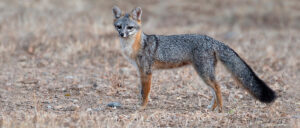by Joe Eaton

(Full article from RATS Tales March 2023)
While birds of prey were the first sentinels of the danger anticoagulant rodenticides (ARs) pose to wildlife, there’s mounting evidence that carnivorous mammals are also at risk. Last year, wildlife scientists in the northeastern US shared their findings on rodenticide exposure in mammalian predators at a conference of the Northeast US Animal Health Association. Adding to what was already known from the fisher studies of SUNY graduate student Georgianna Silveira, they described pervasive AR exposure in a range of species across the region: red and gray foxes, bobcats, even, unexpectedly, river otters. Researchers like David Needle at the University of New Hampshire and Jacqueline Frair at SUNY are studying patterns of exposure and planning to look into possible connections between ARs and disease.
Any mammal or bird that eats a rodent that has consumed rodenticide is a potential victim of secondary poisoning. Studies have found ARs in bobcats and mountain lions in California, fishers in California and Washington, red foxes and other carnivores in Europe, servals in South Africa. In bobcats, and likely in mountain lions, ARs have immune-system effects, leaving the felines vulnerable to potentially deadly mange infections.
Within the region that includes the New England states, New York, Pennsylvania, and New Jersey, AR exposure appears to vary significantly from state to state. For foxes, fishers, and bobcats, New Hampshire is a hot spot. Needle says the first study in the region found an “alarmingly high” percentage of AR exposure in a sample of Vermont fishers. He focused on fishers, red foxes, and gray foxes in his own state, with even more ominous results. All the eleven red foxes and nine gray foxes in his sample had at least trace amounts of ARs, as did all but one of fifteen fishers. “That was a big wakeup call, showing an impact we needed to be talking about,” recalled Needle. Later, bobcats in New Hampshire were found to have a higher percentage of exposure (91) than those in New York (40), New Jersey (36), or Pennsylvania (23).

So far, foxes in other states haven’t been tested; nor have coyotes, widespread in the Northeast. One bright spot: in Maine, only one Canada lynx of 46 tested positive for a rodenticide. Specialist predators on snowshoe hares, lynxes appear to be dodging the AR bullet. “Snowshoe hares are clean,” says Needle. On the other hand, the discovery of ARs in river otters in Pennsylvania raises a red flag about aquatic exposure pathways; see first story.
In New Hampshire, the first-generation AR (FGARs) diphacinone and second-generation ARs (SGARs) brodifacoum, bromadiolone, and difethialone were found in red foxes. Gray foxes, bobcats, and fishers had an additional FGAR, chlorophacinone. Four compounds were detected in Pennsylvania and New York bobcats. Diphacinone showed up in a single Maine lynx, diphacinone and brodifacoum in Pennsylvania otters. Among all species, fishers tested positive for the highest number of ARs, including the FGAR pindone—not legal in the US, used on rabbits in Australia and New Zealand–in Vermont and the FGAR dicoumarol, a precursor to the medical blood-thinner warfarin, in four states. Concentrations of all the ARs were generally low.
The samples represented carcasses turned in to state wildlife agencies by fur trappers (mandatory for some species in some states), roadkill victims, and others found dead in the wild. They weren’t examined for possible sublethal rodenticide effects. However, the fate of several radio-collared fishers in New York is suggestive. “Fishers in the Adirondacks died as they were being handled or very shortly afterward,” Frair recalled. “Their necropsies looked fine; there wasn’t a lot of bleeding. Only one had extra-high levels of rodenticide.” While their deaths remain a mystery, researchers are looking into possible interactions between ARs and wildlife diseases, as documented for bobcats in California with notoedric mange. While that’s apparently not an issue for northeastern bobcats, sarcoptic mange is a serious concern with red foxes in New Hampshire. Needle and Krysten Schuler at Cornell are seeking a grant to investigate a possible relationship between ARs and mange.
Meanwhile, researchers have been looking at spatial patterns of exposure. “It’s pretty much everywhere in New Hampshire,” said Needle. “We had one from way up north and a lot of positives in the White Mountains.” He sees no clear relationship with agriculture or forestry and suspects AR use in suburban and exurban settings, including vacation homes and hunting camps, is a primary source. In his state, bobcats often hunt in woodlots surrounded by residences: “They’re perfect places for ambush hunting.” Frair points to the wildland-urban intermix—a mosaic of housing and forest—as a likely driver of exposure, at least in New Hampshire, Vermont, and New York: “There are tons of private inholdings.”
Frair has found that AR poisoning appears to track the cyclical fruiting of beech trees; beechnuts fuel population booms of red-backed voles and other native rodents that invade homes and cabins. “In some years you can’t buy a snap trap for love nor money,” she added; residents resort to rodenticides. Bobcats and fishers prey on a variety of rodents in addition to rabbits and other mammals, and both red and gray foxes are consummate mousers.
Compared with California and other states, the northeastern region’s wildlife agencies aren’t generously funded. That’s prompted a lot of collaboration across state lines. “We pinch-hit for each other a lot,” Frair noted. She said data are available for commercially significant furbearers like bobcats, fishers, and foxes, but not for the region’s coyotes: “No one is looking at them. There’s no agency driving rodenticide-focused studies. And we haven’t looked at sublethal effects; we’ve only just started that in the Northeast. We need to pay more attention to animals that are dead from other sources [besides trapping.]” More studies like Silveira’s fisher work are needed: “We’re trying to demonstrate rodenticide effects to the level of the potential decline of populations.”
